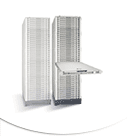
There are a variety of ways to create content. The easiest
way is to use a Web content publishing tool such as Macromedia Dreamweaver, Macromedia Fireworks or a variety of other
free publishing tools that you can find on the internet.
Other tools that are helpful include graphical editing
tools such as Paintshop Pro and even more dynamic content generators
like Macromedia's
Flash. You may also wish to edit your contents yourself
by using a text editor and learning HTML. Here are some
pointers to learning HTML


Once you've finished your page/site, you'll need to upload
it to your web server. FTP (File Transfer Protocol) allows
a person to transfer files between two computers, generally
connected via the Internet. You can either FTP your files
via the command line (i.e. DOS), or you can find yourself
an FTP client which executes all the commands in a drag-and-drop
interface. We would highly recommend the latter to beginners
and experts alike. FTP clients make the publishing process
simple.
FTP Basics
To FTP, you will need to know the host location (i.e.
www.yourdomain.com), as well as your username and password.
All your web site contents are stored in /www/.
Using an FTP Client
Most FTP clients have the same basic layout, functionality,
and price. Choosing one is simply a matter of personal
preference. Some of the more popular clients for Windows-based
computers include WS_FTP,
CuteFTP, and BulletProof
FTP and for Macintosh computers include Fetch,
and Interarchy.
All clients come with documentation, and it shouldn't
take you long to figure out how to get started. But here
are a few basics:
- There will be some kind of "Site Manager"
feature which will store all your FTP locations and
their corresponding login information. Once you enter
this info, the client will automatically log you in.
- There will be three screens. One representing
your local machine, one representing the remote host,
and one which shows the files that are queued for
transfer. You will need to navigate to the correct
folders on both your local machine and the host machine.
- You will then highlight the files you
wish to upload on your local machine, and there should
be a button at the top that queues the files for upload.
The upload might execute immediately, or you might
have to hit a "Go" button first.
- That's it! Your files are uploaded!
You should now be able to go to your URL and view
the page.

 |

Search Engines and Internet Catalogs
Probably the most common way to publicize your site
and generate traffic is to submit it to search engines
(i.e. Google) and internet catalogs (i.e. Yahoo!). Most
of these sites have a form you can fill out to submit
your site. To save yourself some time, you can try a
service that submits your site to multiple search engines
and internet catalogs by filling out just one form.
There are many of these services out there, such as
www.submit-it.com. By adding
meta tags to your site, you can increase the relevancy
of your pages in people's searches. Meta tags will be
discussed a bit later.
Reciprocal Links
If your page has a theme, seek out pages with similar
themes and ask the webmaster to post a link to your
site. In exchange, you promise to add a link to their
site on yours. This is a great way to get the word out
about your site for free.
Newsgroups
Look for newsgroups where you think people who would
be interested in your site might frequent. Post a message
announcing your site and its features. Don't do this
too often as it is sometimes considered Spamming (unsolicited
advertising).
Web Rings
If there are other pages that are similar to yours,
there might be a web ring out there dedicated to your
kind of site. Do an internet search for "web ring" and
include a keyword related to your site. If you join
a web ring, you will need to add a web ring graphic
and links to your page.
Advertising
If you really want to give your site some exposure,
you can create a banner ad and find a company that will
get your banner put up on numerous pages. The cost generally
depends on the amount of impressions (how many times
it is seen) or click-throughs (how many times it is
actually clicked on).

|



